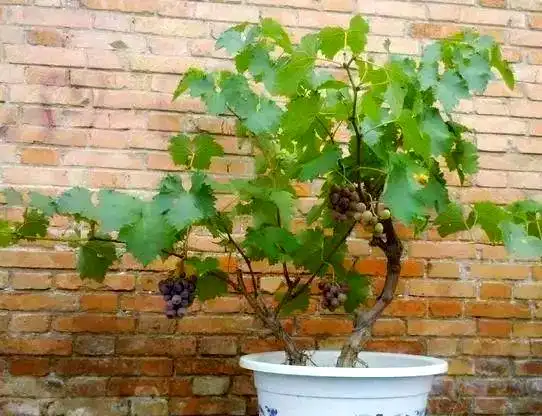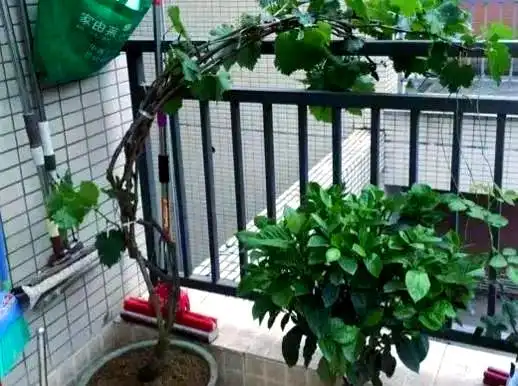Grape bonsai tree, with its various shapes and crystal fruits, means prosperous business and brings beautiful visual enjoyment. The new leaves are light green and tender, giving off a childish look, like a newborn calf; while the mature leaves look oily green and thick, showing a steady and sophisticated state. The ears hang down and are faintly visible, like a girl's face, making people feel a sense of purity and joy when watching it in their spare time. So, how can we make such a Grape bonsai tree? Next, we will introduce to you in detail the cultivation and production techniques of Grape bonsai tree.

011. Variety selection
Generally, we recommend choosing fresh grape varieties with full grains, attractive fruit shapes, bright color, tight ears and long viewing periods. For example, Jufeng, black ti, nuclear free white, nuclear free purple and beauty finger are all good choices.
022. Cultivation techniques for Grape bonsai tree Soil selection

requires deep cultivation and fertilization, and early-maturing large-fruit varieties suitable for potted plants should be selected. Grapes can grow in all soils except heavily saline-alkali soils. Before cultivation, the soil should be deeply cultivated and a large amount of organic fertilizer should be applied to improve the fertility of the soil. At the same time, it is necessary to select early-maturing large-fruit varieties suitable for potted plants to ensure the healthy growth of Grape bonsai tree.
Open field cutting technologyIn mid-April in the north, it is suitable for open field cutting of Grapes. When cutting, tilt the cuttings at a certain angle to ensure that they are completely buried in the soil, while noting that the upper bud eye is about 1 cm away from the ground. In addition, when planning the planting behavior of Grapes, they should be made to move towards north and south, and the plant spacing and row spacing should be reasonably set at 17 to 20 cm and 130 to 150 cm respectively to facilitate the growth and management of Grapes.
 Select
Select a ceramic basin with a diameter of 35 to 50 cm for pressing basin shaping to ensure that it has good water permeability and air permeability, and that the basin soil is rich in organic matter. Before the spring Grapes sprout, bury the pots in the soil in turn with a row spacing of about 35 cm, paying attention to the pot surface being slightly lower than the ground. After that, gently pull down the branches with full buds and fruiting ability to ensure that the vines are not less than 80 centimeters long, then press them into the basin and fill them with soil. Leave 4 to 5 full bud eyes on the pot soil, then insert a 120-cm-long thin rod and tie the branches firmly to it. After 20 days after the Grapes sprout, girdle the branches and vines in the pot to promote early and more roots. The girdling position should be close to the root of the plant and the length should be controlled to 2 cm to ensure that the cortex is completely peeled off. After the cuttings bear fruit, 5 leaves need to be left above the ear for picking to keep the height of the plants in the pot below 120 cm. Four to six ears can be left in each pot, but before flowering, half of the fruits in each ear need to be removed to ensure the regularity of the ears and the uniformity of the fruit grains.
 Fertilizer and water management
Fertilizer and water management Keep the basin soil moist after germination, and combine fertilization to promote ear development. After the Grapes sprout, water should be watered in time to keep the soil moist and promote root growth. In dry weather, watering is necessary every 4 to 6 days, and the basin surface is covered with wheat bran or straw after watering to reduce water evaporation. In addition, after Grapes fall, nitrogen and phosphorus compound fertilizers should be applied once every 15 days in conjunction with watering, and the concentration should be controlled at 3% to 5%, to promote ear development and plant health.
It takes 70 days for pot cutting and marketingto sprout and expand, and pot cutting needs to be carried out during the vigorous growth period. Grapes usually take a growth cycle of 60 to 70 days from germination, flowering to berry expansion. At the end of this stage, the root system in the pot was quite developed, providing suitable conditions for pot cutting. Whether the Grapes are transplanted to the ground or continued to be potted, the survival rate is quite high. Within five days before cutting pots, plant ash extract at a concentration of 2% to 3% needs to be sprayed to the leaves twice in a row to replenish nutrients. Before cutting the pot, some young branches and leaves should be appropriately removed to reduce excessive water evaporation. The pot cutting operation should be carried out in the evening, when water is poured through, and then scissors are used to cut the branches and vines outside the pot near the roots of the plants. After that, you just need to wait for the grape leaves to not wither at noon on a sunny day before you can put them on the market.
033. The production of Grape bonsai tree
: Summer cutting and seedling raising and autumn outplanting. Green branch cutting is used in summer and is outplanting in autumn of that year, thus significantly shortening the seedling raising period. Due to its high survival rate and excellent seedling quality, green branch cuttage has been widely used in grape seedling production.
 Production and maintenance
Production and maintenance In suitable seasons, such as the summer planting and seedling raising period from June to August, we can start making Grape bonsai tree. First, choose healthy and moderately ripe grape branches as material, with a length of 15 to 20 centimeters. Next, perform appropriate pruning to ensure that the slope of the cut is moderate and the upper cut is about 1 cm away from the upper bud. Remove excess leaves and retain the top 1 to 2 leaves to facilitate photosynthesis and nutrient absorption. Finally, insert the pruned grape branches into the pot soil at a plant spacing of 10 cm ×15 cm, gently compact the soil, and fully water them to closely integrate the branches with the soil. After the cuttings survive, they can be moved to a sunny place for daily management and enjoy the greenery and vitality brought by the Grape bonsai tree.
044. Follow-up maintenance
Summer and autumn managementAdequate watering is required in summer, and phosphorus and potassium fertilizers are added in early autumn. Grape bonsai tree needs special attention in summer, because the amount of pot soil is reduced at this time, and the grape leaves are large and have strong transpiration, which can easily lead to water loss and wilting. Therefore, we need to water it promptly and adequately, especially in hot weather, where any negligence may cause damage to the leaves. At the same time, in order to keep the leaves healthy, we also need to spray water regularly. In the early stage of grape growth, appropriate amount of topdressing mainly with nitrogen fertilizer should be applied, but the principle of "applying thin fertilizer frequently" should be followed to ensure the healthy growth of Grapes.
 Autumn, winter and spring management
Autumn, winter and spring management As autumn leaves fall, Grape bonsai tree enters autumn management. Prepare for growth in the coming year by turning and pruning. Turning pots in autumn is particularly important. It not only helps plants survive the winter smoothly, but also lays the foundation for growth in the coming year. During the process of turning the pot, we usually need to remove some old soil and cut off dead roots. At the same time, we need to appropriately cut or cut off the fibrous roots that are coiled on the bottom of the pot or wall of the pot. In addition, pruning of branches is also a link that cannot be ignored during this period. The pruning work should be carried out after falling leaves and before germination in the spring of the following year. Taking into account the shape of the bonsai and the growth of the plant, methods such as thinning, removing pest and insect branches, dry branches, excessively dense branches, thin and weak branches and long branches should be used.
Spring is a critical period for pest control. Control water volume and control pests and diseases. During the growing season of Grape bonsai tree, it is recommended to spray fungicides such as chlorothalonil or thiophanate-methyl every two weeks to prevent the invasion of diseases. Since many insects, eggs and bacteria overwinter in the branches, stems and subcutaneous skins of Grapes, measures need to be taken to eliminate these hidden dangers. Specifically, the old skin can be sc*d off and burned or buried deeply together with pest branches and dead branches. At the same time, the main trunk and branches can be sprayed with Baume 3-5 degrees stone sulfur mixture to eliminate potential bacteria and pests.